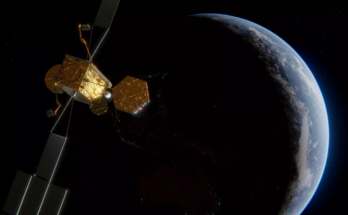by Bill Ostrove, Space Systems Analyst, Forecast International.
While at the 2016 Farnborough Air Show, I had the opportunity to speak with Robin Sampson, a sales manager at Clyde Space, a Scottish satellite equipment manufacturer. The conversation revealed interesting information about Clyde Space as well as some of the major trends within the growing small satellite market.
Clyde Space has become a major player in the smallsat industry. The company says it has about 60 satellites currently under construction for various customers, including the Goddard Space Flight Center, Outernet, and Spire. While it is well known for building small satellites, Clyde Space also builds spacecraft power systems. The company actually got its start manufacturing smallsat components, particularly batteries and power systems.
Clyde Space specializes in CubeSats in 1-, 3-, 6-, and 12-unit form factors. These sizes are the most popular within the small satellite market. Currently, 1U and 3U CubeSats make up the majority of the market. However, as more capabilities are demanded, the 6U and 12U platforms are expected to increase in popularity. This will be especially true for science missions.
Clyde Space provides a variety of manufacturing options to meet its customers’ needs. The company specializes in satellite platforms and power systems. If other components are needed, contracts are made with the manufacturers of those subsystems. In that way, Clyde Space can provide a complete turnkey solution for a customer that does not have design or manufacturing expertise. Alternatively, Clyde Space is able to work with customers to incorporate subsystems into an overall design. For example, if a customer designs an imaging sensor, Clyde Space can incorporate that component into its satellite platform. This flexibility is important in the current market climate, since many small satellite operators will design their own mission-critical equipment in-house.
SeaHawk
Clyde Space is working with the University of North Carolina Wilmington, Cloudland Instruments, NASA Goddard Space Flight Center, and Hawk Institute for Space Sciences on a mission to study ocean biology. The goal of the program is to develop small satellites to detect ocean color at a resolution of 50 meters. Ocean color data enable scientists to derive chlorophyll concentrations and observe elemental cycles. With the retirement of imagers such as SeaWiFs and MERIS, scientists have not had access to ocean color data from satellites.
The Sustained Ocean Color Observation from Nanosatellites (SOCON) project is a response to this need. Small satellites are valuable for this type of mission since they can provide global coverage for a much lower cost than that of previous missions. For example, the SeaWiFs sensor took 10 years to develop and cost $14.1 million. Using 3U CubeSats, the first phase of SOCON (which will construct and launch two spacecraft) is expected to cost $1.7 million. The project was announced in 2015 and the two test spacecraft are expected to launch in 2017, a turnaround of only two years. Project leaders hope the mission will eventually consist of dozens of satellites providing global coverage and frequent revisit rates.[i]
Clyde Space will not only provide the platform but also the subsystems, including the highly efficient Third Generation FlexU EPS, high-performance solar panels, and a 30 Wh lithium polymer battery. SeaHawk will generate an immense amount of data (around 1.1 gigabits for the full observation sweep).
Spire
Originally called NanoSatisfi, Spire provides maritime tracking services and meteorology data. The company plans to deploy a fleet of 50 so-called Lemur satellites that will gather GPS radio occultation data that can be included in weather forecasting models. Early satellites were funded through a crowdfunding campaign. The company later raised $65 million over two funding rounds.
Clyde Space is a major partner on Spire’s constellation. With the signing of a GBP940,000 (about $1.5 million at the time) contract in 2014 for power systems and solar cells, Clyde Space became Spire’s largest subcontractor.[ii]
Outernet
Outernet is a space startup with the goal of broadcasting information to users in developing countries for free. Clyde Space is building three 1U CubeSats for Outernet. These initial platforms will test the functionality of the full constellation. The company is using its standard 1U platform for the mission, and is also providing solar panels, the electric power system and battery, and the onboard computer. The three Outernet satellites are expected to launch later this year.
New Technologies
As one of the major players in the emerging small satellite market, Clyde Space is at the forefront of a number of trends and innovations in the market. One of the most interesting ideas that Sampson talked about was deployable components. Under this arrangement, satellites would be designed in standard CubeSat form factors; however, components such as solar cells, imaging sensors, or communications apertures would deploy from the satellite once in orbit. This would allow the satellites to be launched in standard containers (saving launch costs), with the deployed components creating a larger surface area (resulting in improved capabilities). Larger antennae would enable the satellites to transmit higher bandwidth, while larger imaging sensors would enable higher-resolution imagery.
[i] http://www.satnews.com/story.php?number=972377587
[ii] http://www.spacedaily.com/reports/Clyde_Space_expands_and_announces_new_orders_999.html
Forecast International offers two Space Systems Forecast products: Launch Vehicles & Manned Platforms, with reports on manned spacecraft, expendable launch vehicles and more, and Satellites & Spacecraft, with coverage ranging from microsatellites to large COMSATs – all complete with technical specifications and forecast details. 
A military history enthusiast, Richard began at Forecast International as editor of the World Weapons Weekly newsletter. As the Internet grew in importance as a research tool, he helped design the company's Forecast Intelligence Center and currently coordinates the EMarket Alert newsletters for clients. Richard also manages social media efforts, including two new blogs: Defense & Security Monitor, covering defense systems and international issues, and Flight Plan, which focuses on commercial aviation and space systems. For over 30 years, Richard has authored the Defense & Aerospace Companies, Volume I (North America) and Volume II (International) services. The two books provide detailed data on major aerospace and defense contractors. He also edits the International Contractors service, a database that tracks all the contractors involved in the programs covered in the FI library. More recently he was appointed Manager, Information Services Group (ISG), a new unit that encompasses developing outbound content for both Forecast International and Military Periscope.



